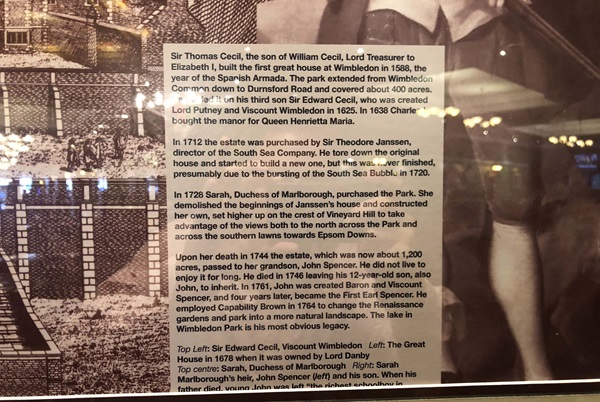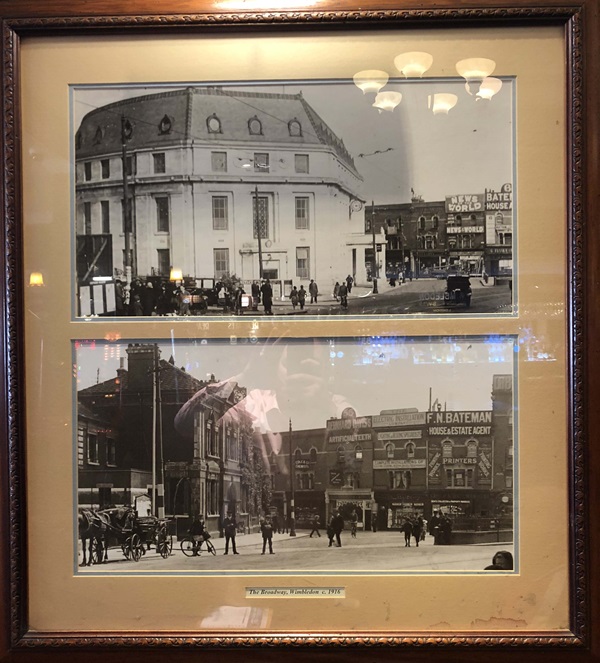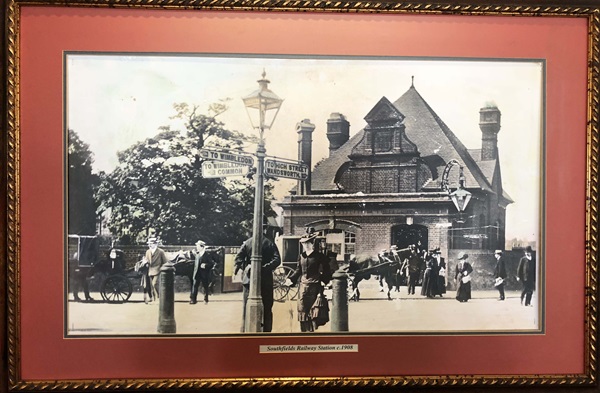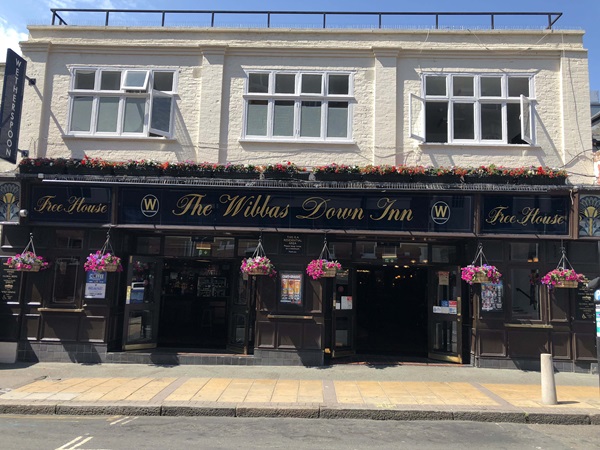This pub takes its name from an early spelling of the name Wimbledon. It was also recorded as Wibbandune, supposed to have been the scene of a 568 AD battle between Ceawlin (King of Wessex) and Ethelbert (King of Kent) in which Ethelbert was defeated.
Text about the first great house at Wimbledon.

The text reads: Sir Thomas Cecil, the son of William Cecil, Lord Treasurer to Elizabeth I, built the first great house at Wimbledon in 1588, the year of the Spanish Armada. The park extended from Wimbledon Common down to Durnsford Road and covered about 400 acres. Bestowed it on his third son Sir Edward Cecil, who was created Lord Putney and Viscount Wimbledon in 1625. In 1638 Charles I bought the manor for Queen Henrietta Maria.
In 1712 the estate was purchased by Sir Theodore Janssen, director of the South Sea Company. He tore down the original house and started to build a new one, but this was never finished, presumably due to the bursting of the South Sea Bubble in 1720.
In 1728 Sarah, Duchess of Marlborough, purchased the park. She demolished the beginnings of Janssen’s house and constructed her own, set higher up on the crest of Vineyard Hill to take advantage of the views both to the north across the park and across the southern lawns towards Epsom Downs.
Upon her death in 1744 the estate, which was now about 1,200 acres, passed to her grandson, John Spencer. He did not live to enjoy it for long. He died in 1746 leaving his 12 year old son, also John, to inherit. In 1761, John was created Baron and Viscount Spencer, and four years later, became the First Earl Spencer. He employed Capability Brown in 1764 to change the Renaissance gardens and park into a more natural landscape. The lake in Wimbledon Park is his most obvious legacy.
Top left: Sir Edward Cecil, Viscount Wimbledon
Left: The great house in 1678 when it was owned by Lord Danby
Top centre: Sarah, Duchess of Marlborough
Right: Sarah Marlborough’s heir, John Spencer (left) and his son. When his father died, young John was left ”the richest schoolboy”.
A photograph and text about Robert Graves, Wimbledon’s leading 20th century poet.

The text reads: Robert Graves’ family lived in Wimbledon. He was born in 1895 and attended a number of schools, and hated them all. His father was an inspector of schools, and a minor poet. His mother Amy was Alfred Perceval Graves’ second wife. Her family were German academics.
Robert went on to Charterhouse, and from there was pitched directly into the First World War. His first poems were published during the War. He survived, proving a devoted, loyal and courageous soldier, serving with the Royal Welch Fusiliers.
Nevertheless he suffered shell-shock, and his post-war marriage to the artist Nancy Nicholson was not a success. He was obsessively re-writing poems, plaques by phobias (terrified of trains and telephones amongst many other things), and made intense sexual demands of his tired and overworked life.
Graves brought Laura Riding into his home, and became enslaved to her. After publishing his autobiography, Goodbye To All That, in 1929, he went abroad with her. He returned to England for the second wife Beryl Hodge, where he died in 1985.
His best known works are his historical novels I Claudius the God. His ideas on poetry are laid out in The White Goddess.
Photographs of the Broadway, Wimbledon, c1916.

A photograph of Southfields Railway Station, c1908.

External photograph of the building – main entrance.

If you have information on the history of this pub, then we’d like you to share it with us. Please e-mail all information to: pubhistories@jdwetherspoon.co.uk